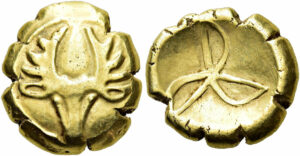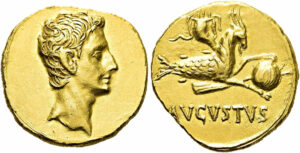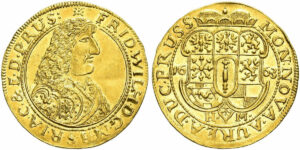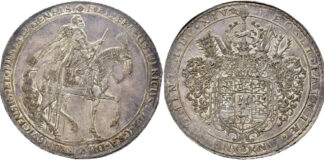Coin Auctions at Gorny & Mosch in October 2022
From 10 to 12 October 2022, auction 289 “Ancient Coins” and auction 290 “Selected Coins and Medals from the Middle Age to Modern Times” will be held by Gorny & Mosch in Munich. Two splendid, printed catalogues complement the sales.
Auction 289
More than 950 ancient coins will be auctioned off from 10 to 11 October 2022 by the Munich auction house Gorny & Mosch in their business premises. A highlight of this sale is the Gert Cleff Collection, including coins of the Achaemenid, the Parthian and the Sasanian Empires. The title of the printed catalogue is adorned with a daric of the Cleff Collection.
Moreover, coins from the following collections are on offer:
- Important Celtic coins from Southern Germany
- Greek coins from various old collections
- A large collection of Roman coins from German private ownership
Auction 290
The auction of modern issues from 11 to 12 October covers more than 1000 coins and medals. Among them are a part of the important Dr. Fritz Spruth Collection with mining and river gold issues.
In addition, the following collections will be on sale:
- Collection of bracteates from the region of Lake Constance
- German gold issues from an old collection
- Special collection Brandenburg-Prussia
- Collection of Bavarian issues from German ownership, Habsburg, Europe
- Islamic coins (Hinrichs Collection, Bremen, part I)
- Special part gold coins (with adjusted bidding increments)
The offer of auction 289 and 290 at a glance:
- Celts: 30 lots
- Greeks: 627 lots
- Roman provincial coinage: 11 lots
- Roman Republic: 59 lots
- Roman Empire: 208 lots
- Byzantium: 16 lots
- Migration period: 1 lot
- Miscellaneous: 3 lots
- Medieval Lake Constance area: 43 lots
- Fritz Spruth Collection: 74 lots
- Germany until 1871: 424 lots
- Germany after 1871: 112 lots
- Medals: 6 lots
- Austro-Hungary: 71 lots
- Europe: 55 lots
- Overseas: 8 lots
- Islamic issues (Hinrichs Collection, part I): 82 lots
- Special part gold coins: 159 lots

- 16: Celts. Vindelici. Deer head type. “Rainbow cup” ø 17mm (7.61g). 150 – ca. 90 BC. Gold! Very rare! About extremely fine. Estimate: 25,000 euros
Among the Celtic issues, this “rainbow cup” stands out, as it is a very rare type: the obverse features a deer head with particularly large antlers, representing the Celtic deer God Cernunnos, the deity of fertility and growth. Among other things, a specimen of this type is one of the most popular exhibits of the Bavarian State Collection in Munich.

- 510: Greeks. Achaemenids. Type IV (early). Persian daric ø 17mm (8.32g). Period of Artaxerxes II – Artaxerxes III, ca. 375 – 340 BC. Gold! Very rare! Extremely fine. Estimate: 5,000 euros
In the section of Greek coins, a Persian daric from the time of Artaxerxes II to Artaxerxes III represents the Gert Cleff Collection from Wuppertal, which contains numerous peculiarities and rarities of the coinage of the Ancient Near East. This type is a very rare specimen. Among lots No. 511-514, an even rarer variety of this type is on offer: the reverse features a mark in the shape of a lion’s head, which is probably a reference to the Sardis mint.
- 673: Roman Republic. Ear of grain, 211– 210 BC. 20 asses ø 10mm (1.12g). Gold! Rare! Extremely fine to FDC. Estimate: 5,000 euros
A rare example for the coinage of the Roman Republic is this gold specimen of 20 asses. Minted around 211 BC in the final phase of the Second Punic War, the obverse shows Mars, the god of war and defender of Rome. The myth has it that he was the father of Romulus, the founder of Rome. The eagle on the reverse symbolizes strength and immortality in the face of the calamity of war. It is most likely that gold was sent to Rome from the Ptolemaic Empire and the reverse type with the eagle on a thunderbolt, known from Ptolemaic coinage, is Rome’s tribute to the Ptolemaic Empire for the financial help.

- 728: Roman Empire. Augustus, 27 BC – AD 14. Aureus ø 20mm (7.90g). Gold! Die re-engraved in ancient times on obv. and rev., extremely fine. Estimate: 15,000 euros
The Capricorn can already be found on the early coins of Augustus. It is the zodiac sign under which Augustus was born. When Augustus was still unknown as C. Octavius studying in Apollonia, the astrologer Theogenes knelt down before him in awe because of the unique constellation of the stars at the time he was born. Suetonius recounts: “From that time on Augustus had such faith in his destiny, that he made his horoscope public and issued a silver coin stamped with the constellation Capricornus, under which he was born” (Suet. Aug. 94). Later, the Capricorn was featured on coins on the occasion of victories and peace campaigns to show that Augustus was destined by the stars to bring salvation to the state.
- 1061: German Coins and Medals until 1871. Bavaria. Maximilian III Joseph, 1745 – 1777. Ducat, 1762, Munich. Gold. Very rare! Fine toning, slightly bent, about BU. Estimate: 25,000 euros
The Isar gold ducat is from the Dr. Fritz Spruth Collection, which contains yield and mining issues as well as river gold and silver coins. The trained mining engineer Spruth devoted his spare time to the related field of numismatics, and also wrote several standard works on mining issues. The gold ducat offered by Gorny & Mosch is probably the best-preserved 1762 specimen that is currently on the market.

- 1293: German Coins and Medals until 1871. Brandenburg / Prussia. Frederick William, “the Great Elector”, 1640 – 1688. Ducat, 1663 HM, Königsberg. Extremely rare! Showpiece. Slightly bent, about BU. Estimate: 25,000 euros
This piece is extremely rare and comes with an old document. It is probably from the Joseph Rainer Collection, which was sold in 1902 by Otto Helbing in Munich.
e-auction 291
On 8 November 2022 starting at 10 a.m., coins, medals and multiple lots from antiquity to modern times will be auctioned off online. The offer includes, among other things:
- several Celtic, Greek and Roman coins
- Achaemenids, Parthian and Sasanian issues from the Gert Cleff Collection
- multiple lots with colonial AEs from the E.L. Collection
- German and European coins, Bavaria and overseas
The viewing takes place at Gorny & Mosch, Maximiliansplatz on the following dates starting now: Monday – Friday, 10 a.m. – 1 p.m. and 2:30 p.m. – 6 p.m., Sunday, 9 October 2022, from 10 a.m. to 6 p.m. and after prior appointment.
The catalogues for auction 289-290 can be ordered at Gorny & Mosch, Giessener Münzhandlung, Maximiliansplatz 20, 80333 Munich, Germany, phone: +49 (0)89 24 22 643-0, fax +49 (0)89 22 85 513. They are also available online.
For further information, visit the website of Gorny & Mosch.




